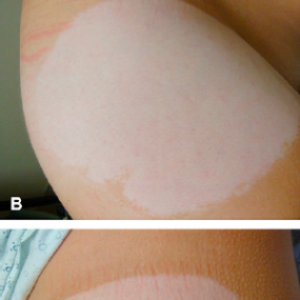Chemical Leukoderma from Daytrana Skin Patch Causes Permanent Scarring

Following recent FDA warnings about the risk of chemical leukoderma from Daytrana patch side effects, many users are recognizing that the loss of skin color following repeated application of the attention deficit and hyperactivity disorder (ADHD) skin patch may be permanent.
Daytrana (methylphenidate transdermal system) is a once-daily medicated patch, which was initially approved by the FDA in 2006 for treatment of ADHD. However, many users have suffered skin pigment changes after wearing the patch, known as chemical leukoderma.
While the condition is not life-threatening and is primarily considered a cosmetic skin problem, chemical leukoderma causes the skin pigment cells to either die or cease functioning, often resulting in permanent skin color changes or scarring.

Learn More About
Side Effects of Daytrana Patch May Cause Permanent Skin Color Changes and Scarring.
Learn More About this Lawsuit SEE IF YOU QUALIFY FOR COMPENSATIONLast month, the FDA issued the first warnings about the risk of chemical leukoderma from the Daytrana skin patch side effects, indicating that the manufacturers will be required to update the warning label for the ADHD drug.
According to the drug safety communication issued by the federal regulatory agency, the Daytrana skin color changes often occur where the patch was repeatedly applied or rotated, but the problems have also been reported on areas of the body where the patch was never applied.
Reports of skin color changes on Daytrana appeared anywhere from two months to four years after first use the ADHD patch, but the FDA indicates that the Daytrana scarring was permanent in all cases.
Chemical leukoderma is similar to vitiligo, which may be caused by autoimmune disorders or genetics. The skin problems are most often associated with exposure to certain chemicals, but much still remains unknown about the condition.
In cases where the condition is linked to chemical exposure, it is believed that the cells which create melanin, or skin pigment, known as melanocytes are damaged. This results in patches of white skin or skin with diminished color.
In some cases, the use of immunomodulator creams can restore skin color. In addition, some research has explored the combination of vitamin B12, folic acid supplements and sun exposure as a potential method of restoring skin color. However, most cases appear to be permanent.
Daytrana Skin Patch Problems
Following the recent FDA warning, a number of lawyers are reviewing potential Daytrana chemical leukoderma lawsuits for individuals who have experienced skin color changes or other scarring problems from the ADHD patch.
Given the wide availability of other treatments for ADHD, individuals diagnosed with chemical leukoderma from Daytrana may not have decided to use the ADHD skin patch treatment if they had been aware of the potential risk that they may suffer permanent skin color changes or scars.
Since it was introduced, the Daytrana patch has been linked to a number of different health concerns.
In a January 2013 report by the Institute for Safe Medication Practices (ISMP), which evaluates adverse event reports submitted to the FDA, more than 1,000 incidents involving problems with Daytrana patch were identified in the second quarter of 2012 alone. According to the group, adverse events associated with Daytrana over the four calendar quarters ending in the second quarter of 2012, exceeded those associated with any other drug monitored by ISMP.
During that time period, out of all of the ADHD medications on the market, Daytrana accounted for only 3% of sales, but 99% of the complaints received by the FDA, leading ISMP reviewers to suggest that the FDA should consider issuing a Daytrana recall.
Complaints included children suffering erythema, irritation, rashes, pruritus, burns, erosions, swelling vesicles, urticaria, and involuntary muscle movements. At least one case resulted in severe injury and hospitalization.
About half of the Daytrona side effects identified were linked to drug administration problems, with many parents indicating that problems removing the adhesive backing led to the patch falling off or causing trouble with applying it to their child. There were also 89 cases of drug prescribing error.
The cases of involuntary movements were of particular concern, as in clinical trials there was at least one case where the child’s involuntary movements never resolved. The involuntary movements, often referred to as tardive dyskinesia, are a common complaint among some stimulants, but the ISMP report notes that health experts at the FDA are concerned that Daytrana tardive dyskinesia symptoms seem to appear more often than with other ADHD drugs.
The complaints are nothing new for Daytrana. The first distributor, Dublin, Ireland-based Shire, gave up on the product in 2010, after 10 Daytrana recalls were issued since it was first approved in the United States. The patch’s distribution was taken over directly by Noven Pharmaceuticals, which has issued two recalls since then, one in March 2011 and another in September 2011. The problems with the adhesive being stuck to the protective liner was frequently the cause of the recalls.
Additionally, in December 2013, the FDA issued another warning regarding a number of ADHD drugs, including Daytrana, linking them to long-lasting, and potentially dangerous, erections, known as priapism.
Want a weekly update on top lawsuits, recalls & warnings?
"*" indicates required fields
2 Comments






lisaMay 2, 2017 at 11:09 pm
my daughter has experienced skin coming off when taking the patch off, burning,itching. she now has skin discoloration. she has had rapid heart beat and she cannot gain any weight. i believe the manufacturer should be held liable for this happening. then the manufacturer does not notify anyone about a recall, what is going on with these people. it shocked me to know there was a recall back in 2011[Show More]my daughter has experienced skin coming off when taking the patch off, burning,itching. she now has skin discoloration. she has had rapid heart beat and she cannot gain any weight. i believe the manufacturer should be held liable for this happening. then the manufacturer does not notify anyone about a recall, what is going on with these people. it shocked me to know there was a recall back in 2011 and then 2 more, this is wrong on there part..she suffers while they make millions of dollars? what if were your kid?? i want to hear from someone, (manufacturer anyone why they have continued this medication for the horrible side effects///
LisaJuly 17, 2015 at 11:23 am
I came to know that Long-term use of Daytrana can slow a child's growth. Tell your doctor if the child using Daytrana is not growing or gaining weight properly. Do not use Daytrana on a child younger than 6 years old without the advice of a doctor.[http://www.drugs.com/daytrana.html]